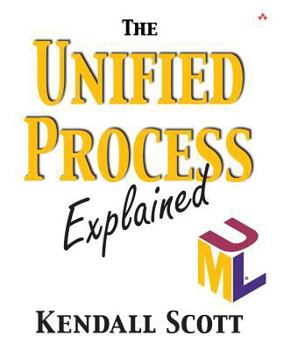The Unified Process Explained
A presentation of the Rational Unified Process (RUP) in simple terms, designed to help developers and managers get up-to-speed with this potentially complex methodology. Kendall Scott seeks to present... This description may be from another edition of this product.
Format:Paperback
Language:English
ISBN:0201742047
ISBN13:9780201742046
Release Date:November 2001
Publisher:Addison-Wesley Professional
Length:208 Pages
Weight:1.00 lbs.
Dimensions:0.5" x 7.4" x 9.2"
Customer Reviews
2 ratings
Should be widely read by software developers
Published by Thriftbooks.com User , 21 years ago
This book solves a very basic problem with the Rational Unified Process: its apparent mystery and complexity.You see, Rational's own documentation tends to be overly academic and self-referential, meaning it uses its own lingo heavily to explain the lingo. This serves well as a reference to a practitioner, but no good as an introduction. And you can't get your whole team, much less your customer, to read thick documentation. You can do an overview presentation for the customer, but I believe team members need much greater understanding of the methodology, and they need it *now*, beforehand, not discovering it as they go.Scott cuts through and succinctly but thoroughly present RUP in about 160 pages. He does this in a consistent, deliberate format. This can be scanned page-by-page in less than 30 minutes by every development team member, and the benefits can be enormous.In my experience, RUP practitioners tend to be one of two types: overly zealous or overly loose. The former regards the process as a set of decree laws around which everyone, including the customers must suffer. The latter, well. This is unfortunate and is usually the result of the team's insufficient buy-in and understanding of the role of a development methodology like RUP. If Scott's explanations are more widely read and understood, more teams would apply the principles more appropriately and produce better results. This book makes this understanding much easier to achieve. I know I'm getting my whole team to read this.The bief end sections comparing RUP with Extreme Programming and ICONIX are very helpful in putting all 3 in perspective, again in a clear, demystifying approach.A minor improvement would have been to present the four phases and five workflows TOGETHER on a few typical visual graphics. He describes them in words as "cuts-through" in a "matrix" but this isn't very helpful, unless of course you already know what he means.
Read this and you will know what the unified process is
Published by Thriftbooks.com User , 21 years ago
Like the Unified Modeling Language (UML), the Rational Unified Process or RUP can be intimidating when first encountered. However, there are simple, introductory books describing them and Scott is the author for the best in each category. In this book, you are gently led through the four phases of each cycle: inception, elaboration, construction and transition. The inception phase is where the case for the viability of the proposed system is put forward and properly answered, although it is not necessary to finalize all the requirements. Basically, this phase ends with a go/no go decision. Once the go decision is made, then the purpose of the elaboration phase is to establish whether your organization is capable or can be made capable of building the proposed project. It is here where the specifications are finalized and the final decision is made whether to proceed with the development. The construction phase is where the building takes place using the modern techniques of iterative, incremental development. Finally, the transition phase is when the final bug fixes are done and the product placed in the hands of the customers. Each phase is characterized by a major milestone. For the inception phase, it is the lifecycle objectives, where the business case is proven strong enough to justify moving on to the next phase rather than terminating the project. The milestone of the elaboration phase is the life-cycle architecture, which is where the main functional requirements have been set down and the initial plan for the construction phase has been developed. The major milestone of the construction phase is when a more-or-less functional beta version of the software is in the hands of customers for evaluation. Finally, the major milestone for the transition phase is that magic moment known as the product release. All of these phases and milestones are described in detail, albeit in simplified form, as befits a primer. Five workflows are continuous throughout the development cycle: requirements, analysis, design, implementation and test. Those early in the list are more prominent at the beginning and then fade to almost nothing at the point of release. The workflows at the end of the list start at almost nothing and rise to prominence at the end of the cycle. This natural progression is yet another way to verify that the project is healthy. Written at a level that is easily accessible to managers, this book can also serve as an introduction for developers. If you are investigating or are planning on using the RUP in your development projects, then this book is the place you should start. Easy to follow, it will show you the basics of what you are getting yourself into.





